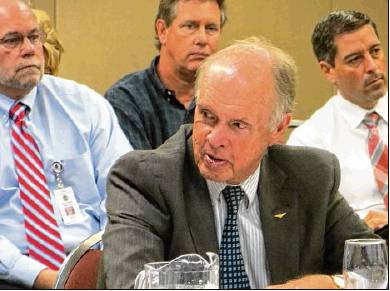PALM BEACH COUNTY IMPACT FEE
Review of impact fees could lead to increase
County has not raised fees collected from developers since 2014.
By Wayne Washington Palm Beach Post Staff Writer
WEST PALM BEACH — Impact fees could be on the way up in Palm Beach County, where the county commission expects to review a report on them sometime in September or October.
The fees, collected from developers when they get permits to build, help the county handle new development’s impact on roads, parks, libraries, schools and emergency services.
They have not been increased in the county since 2014, the final year of a two-year phase-in following a review in 2012.
During a meeting on the fees last week, various commissioners expressed an interest in taking a look at an impact fee increase for all applicable services. The one area where an increase seems less than likely is the impact fee for fire-rescue services. That’s because the county has a separate property tax for fire-rescue, and recent growth in construction has fueled an increase in that fire-rescue tax revenue.
A couple of factors point in the direction of an increase for other services.
Development, particularly in areas west of Florida’s Turnpike, has raised demand for services like roads, parks, libraries and schools. Secondly, the county could in the future be looking at a $30 million annual loss of property tax revenue if voters approve a $25,000 increase in the state’s homestead exemption, which will be on the ballot in November 2018. The proposed amendment to the state’s constitution, placed on the ballot by the Legislature this spring, requires 60 percent approval to pass.
That possible loss of revenue wasn’t part of the impact fee discussion Tuesday, but it has hovered over the county’s budget deliberations this year and it looms as a significant threat to the run of comparatively smooth financial sailing the county has enjoyed in recent years.
Unlike property tax revenue, which can be used in a variety of ways, money collected from impact fees can be used only for specific purposes in specific areas, generally the areas from which they are collected.
Road impact fees, for example, can be used to build new roadways. They can’t be used to pay the salaries of county employees involved in planning or overseeing that road construction, nor can they be used to pay for the operation of a public transportation system.
However, more impact fee revenue would allow the county to use less property tax money in areas where impact fees are used.
Commissioner Hal Valeche said the county was careful not to allow impact fees to get in the way of recovering from the Great Recession in 2008.
“We artificially suppressed them at the beginning of the recovery,” Valeche said. “I think it’s time to remove that suppression.”
The county began assessing impact fees in July 1979, according to a review of the program provided to commissioners last week.
A legal challenge halted the program a few months later, but it was resumed in 1982 and expanded when voters approved an amendment to the county’s charter in 1988.
Impact fees are not collected in the Glades region, an impoverished section of the county where there is little or no growth.
Since 1993, the county has collected $1 billion in impact fees. Most of the fees collected — $560 million — were for roads.
In the years before the recession, the amount of money collected through impact fees grew steadily, from $85.2 million in 2003 to $86.8 million in 2004 to $98.9 million in 2005.
Then, during the recession, the amount of money collected through impact fees fell off dramatically. Fee collections still haven’t come close to returning to pre-recession levels.
In 20012, for example, the county collected $28.5 million in impact fees. It collected $36.6 million in 2013, $31.8 million in 2014, $38.6 million in 2015 and $42.3 million in 2016.
West Palm Beach is studying the possibility of imposing a mobility fee that could give the city a way to pay for transportation costs beyond the road construction covered by road impact fees.
“There needs to be a fundamental shift in the way we view urban mobility,” Mayor Jeri Muoio said in February, when the city hired a consultant to study the possibility of imposing a mobility fee. “This study will help us develop a transportation system that balances bicycle, pedestrian, transit and car travel in a safe, affordable, sustainable manner.”
The county is eager to see what comes of West Palm Beach’s study.
“For me, I would like to see the discussion of the impact fee and the mobility fee,” County Commissioner Mack Bernard said.
The county would need voters to approve an amendment to its charter before a mobility fee could be imposed.
“If doing a charter amendment is something that needs to be done, that’s something I’d be willing to look at,” Bernard said.
While the imposition of a mobility fee is distant, the county could move more quickly to raise the impact fees now in place.
David Kanarek, head of government affairs for the Gold Coast Builders Association, said an “increase in impact fees would result in an increase in housing costs.”
“I know the county is sensitive to the need for affordable and workforce housing,” Kanarek said.
County officials view the scarcity of affordable housing as a crisis, one that required a housing “summit” in May that drew hundreds of government officials, builders, lenders and non-profit leaders.
Kanarek said the housing market would be affected by an increase in impact fees, with buyers of more expensive homes less affected than those looking to buy less expensive houses.
“It’s not up to me to determine what that increase is,” Kanarek said, “but a significant increase could have an impact on home prices.” wwashington@pbpost.com
